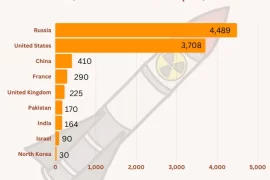
The Nord Stream pipelines, which supply Russian gas to Western Europe, were allegedly destroyed by a team of specialized U.S. Navy divers. According to Pulitzer Prize-winning journalist Seymour Hersh, the divers planted C4 explosives on three Nord Stream pipelines in June 2022, which were detonated three months later using a sonar buoy. The report claims that the bombing attack was in response to Russia’s invasion of Ukraine and was meant to force European nations to reduce their reliance on Russian gas and disrupt Moscow’s income from gas sales.
The Attack
According to Hersh’s 5,000-word report, the divers, who were trained at the U.S. Navy Diving and Salvage Center in Florida, carried out the top-secret operation during a military exercise in the Baltic Sea. The C4 explosives were fitted with sensors that allowed them to be detonated remotely, and the explosions were triggered by a sonar buoy that broadcast a signal.
The U.S. administration has denied the allegations, with the White House and the CIA calling the report “false and complete fiction.”
Planning the Attack
Planning for the attack reportedly began in December 2021 when National Security Advisor Jake Sullivan convened a meeting of a new task force formed of officials from the Joint Chiefs of Staff, the CIA, and the State and Treasury Departments. The objective was to come up with a plan to destroy the two Nord Stream pipelines.
Several ideas were shared, including using a submarine to attack the pipelines or aircraft to drop bombs with delayed fuses, before the dive mission was selected. The CIA director authorized a working group to draw up the plan for the deep-sea divers to carry out the mission.
Base and Timing of the Attack
Norway was selected as the base for the operation due to its hatred for Russia and its experience in deep-sea oil and gas exploration. In March, members of the U.S. planning team flew to Norway for discussions with the Norwegian Secret Service and Navy. They decided to carry out the blasts near Denmark’s Bornholm Island.
The initial plan was to plant explosives with a 48-hour timer, but the White House later asked for a method that would allow more control over the timing of the blasts. The buoy technique was developed, and the buoy was dropped by a Norwegian Navy plane on September 26, 2022, and the explosive detonated a few hours later.
Who said what ?
The explosions that took place in the exclusive economic zones of Sweden and Denmark have been determined to be deliberate by both countries, however, they didn’t disclose the suspect’s name.
The United States and NATO called the blow up incident as “sabotage,” while Moscow accused the Western nations without presenting any proof.
Geopolitical Consequences
The immediate impact of the attack was limited, as the pipelines were not fully operational, but the geopolitical consequences were significant. Russia believes repairs will cost at least $500 million, but the Kremlin has not confirmed the pipes will be fixed.The allegations of U.S. involvement in the bombing of the Nord Stream pipelines have not been confirmed, and the U.S. administration has denied the claims. Nevertheless, the geopolitical consequences of the attack are significant, and it remains to be seen what the long-term impact will be.
White House’s Response
On February 8, 2023, the White House categorically rejected Seymour Hersh’s report as “completely untrue and purely fictional.” Similarly, representatives from both the CIA and the State Department also denounced the report as false.
Next day, State Department spokesman Ned Price told, “It would not be typical for us to engage allies and partners on something that is utter and complete nonsense,” in response to a question about Hersh’s blog post.
Russia’s response
On February 10, 2023, Russian Foreign Ministry spokeswoman Maria Zakharova told reporters that the US State Department’s attempts to dismiss Seymour Hersh’s article as “nonsense” are glaring falsehoods that reveal a startling lack of knowledge of American history.
“The US is once again lying live on air, openly mocking journalists who asked fully justified questions,” she said.
Citing the 1983 CIA sabotage of a pipeline in Nicaragua as an example, Zakharova noted that Washington has a history of targeting civilian petrochemical infrastructure.
She pointed out that Denmark and Sweden rejected Russia’s offers of assistance with the investigation, and Norway declined to offer aid citing EU sanctions, indicating that these three governments were not concerned with uncovering the truth but rather concealing it.
China demands an explanation
Chinese government has demanded an object and impartial investigation into the explosion incident.
China Daily, an English-language newspaper owned by the Central Propaganda Department of the Chinese Communist Party, in its editorial published on February 10, 2023, asked the US to explain the blow up incidence and stated, “If the White House wants the global audiences to believe in its denial of the detailed Hersh report, better show some sincerity by explaining the whole thing at least in equal details.”
“Don’t forget that to attack a major civilian infrastructure as a natural gas pipeline amounts to suspicion of state terrorism,” added the daily.







